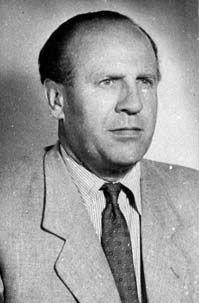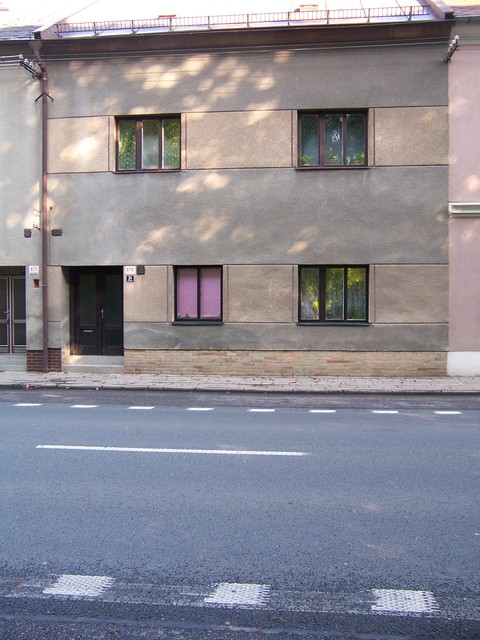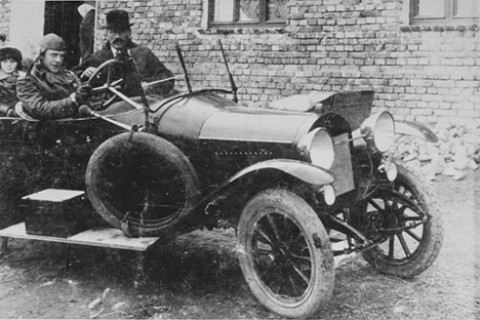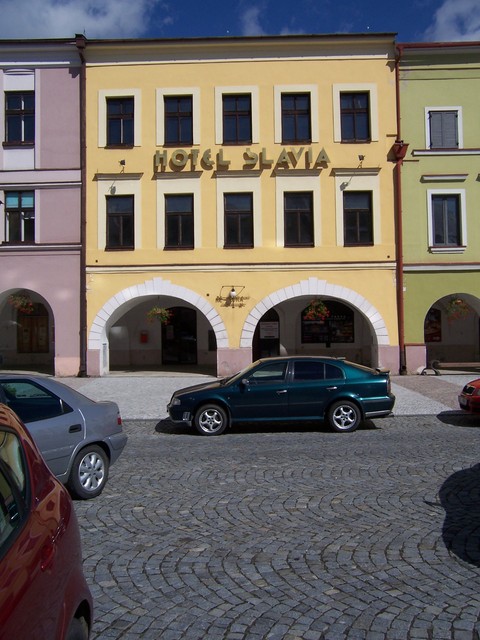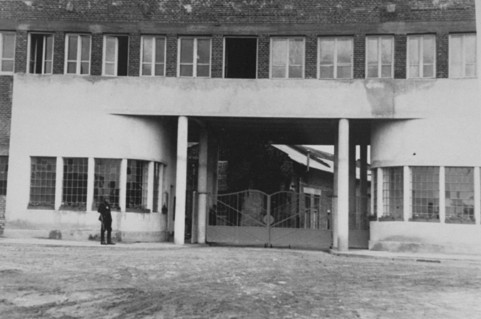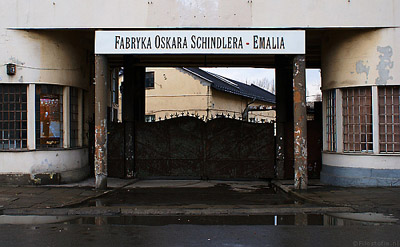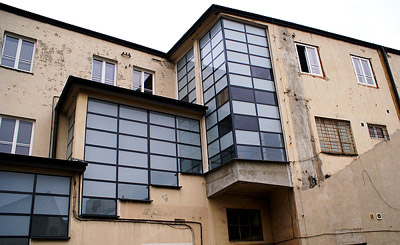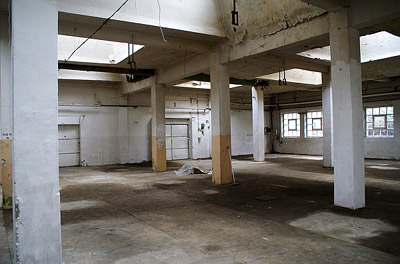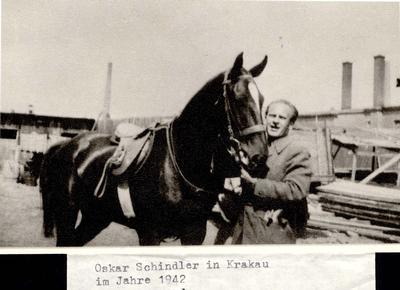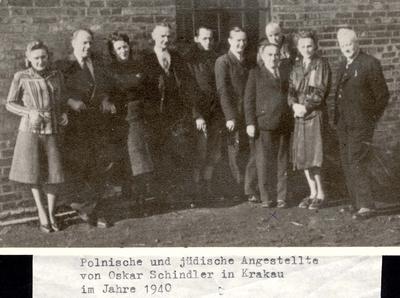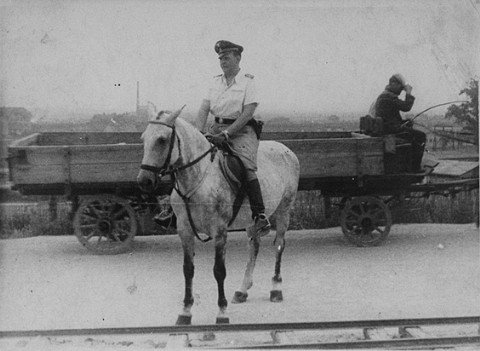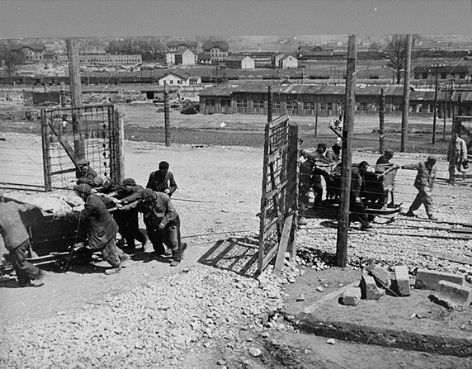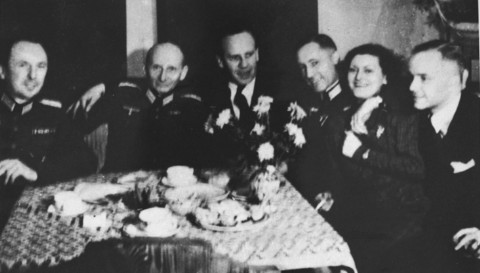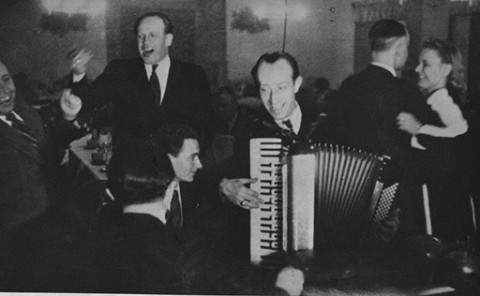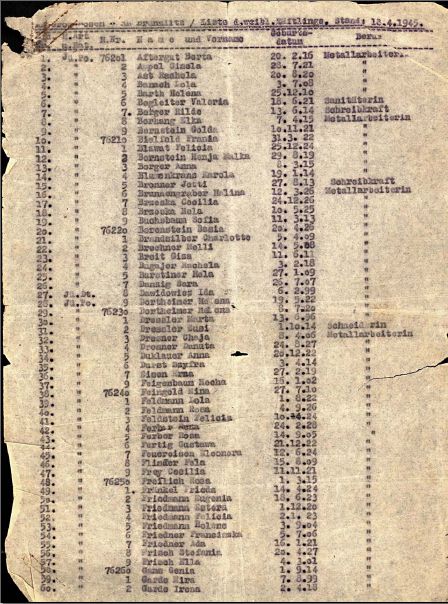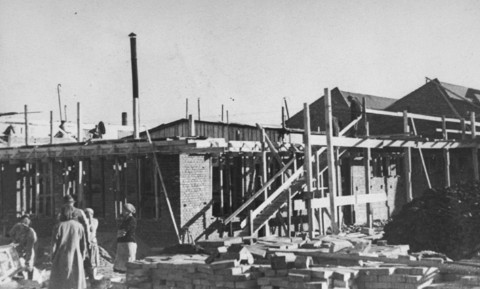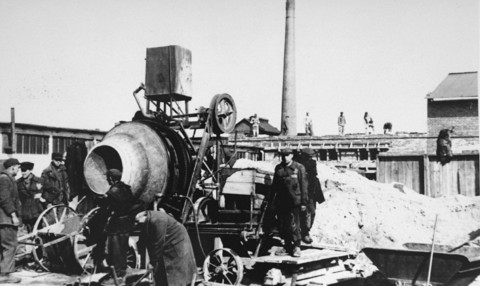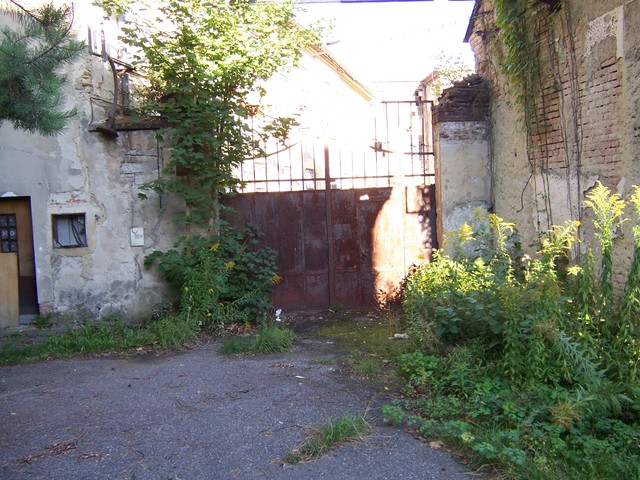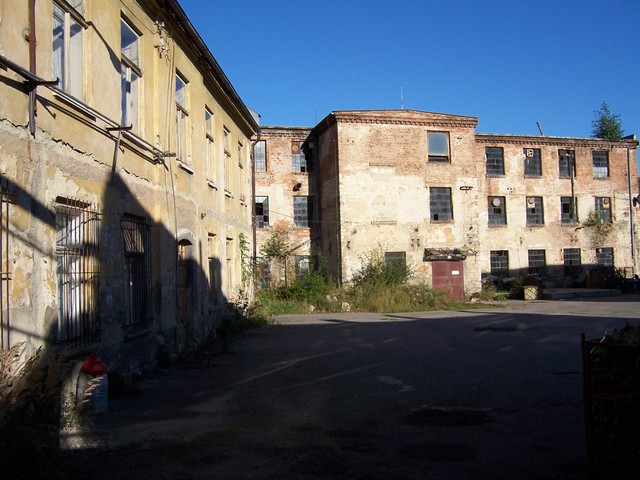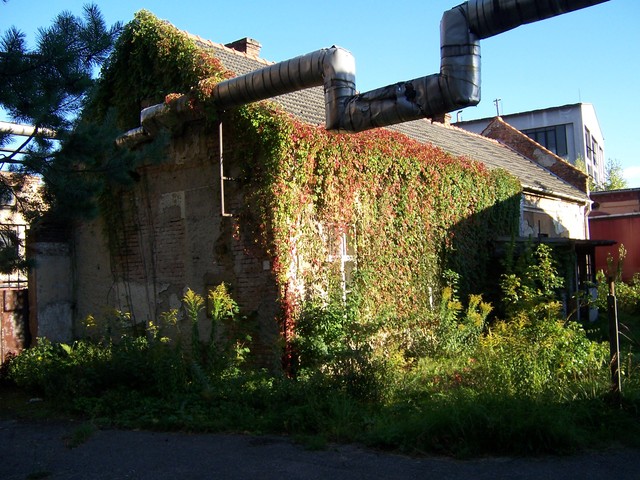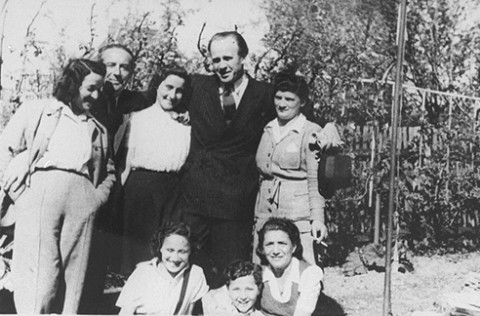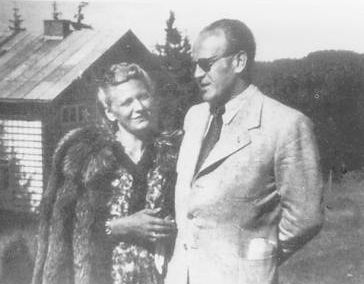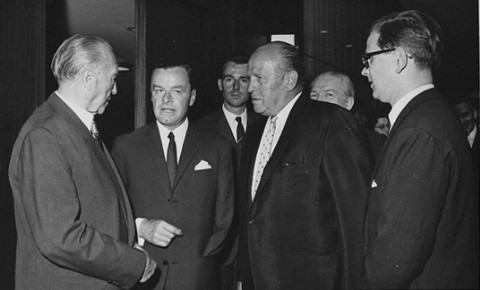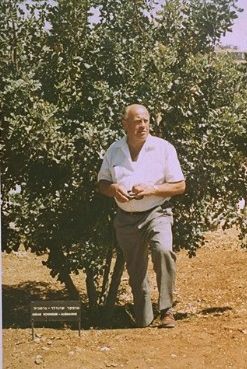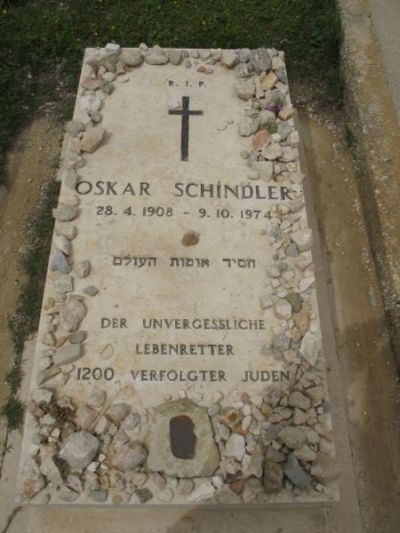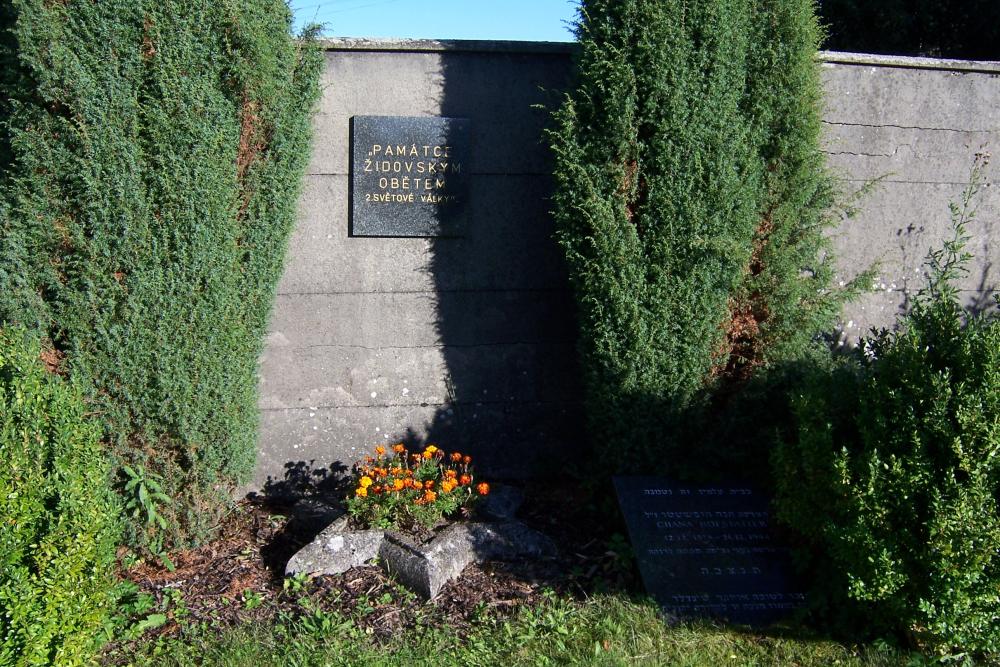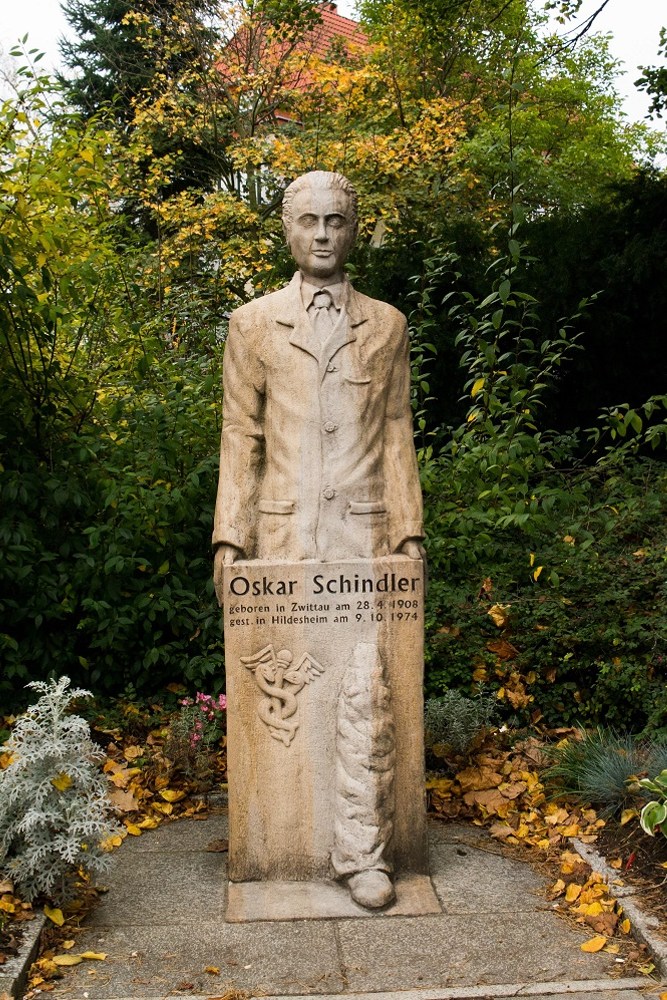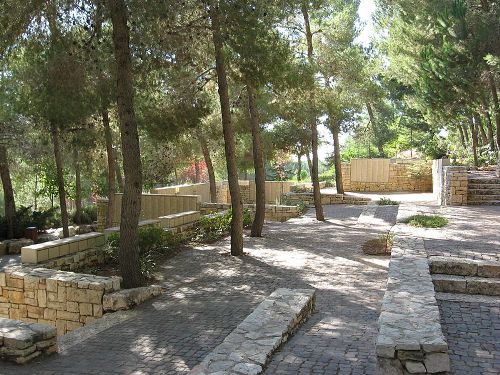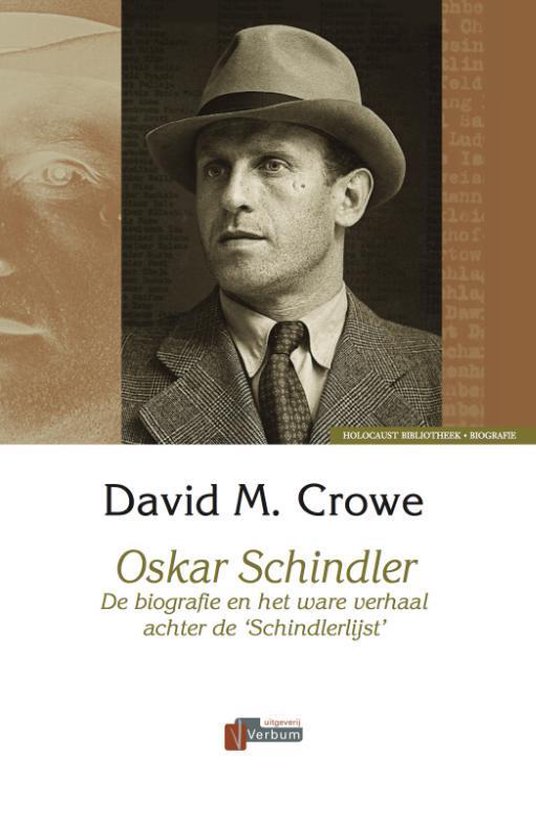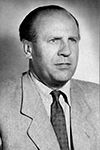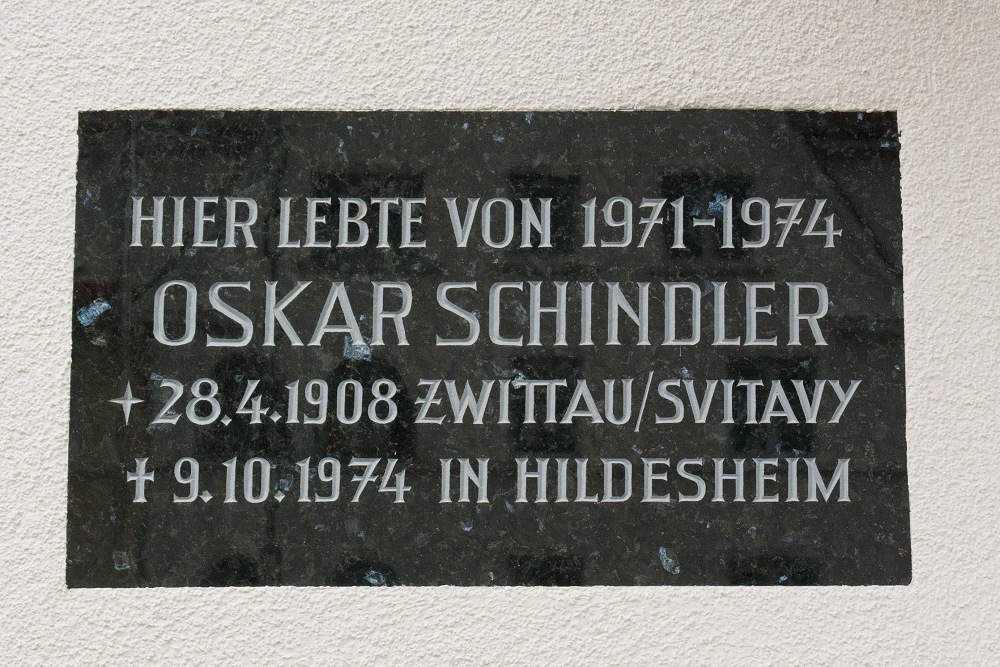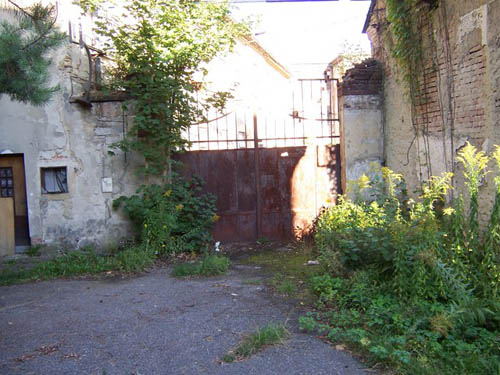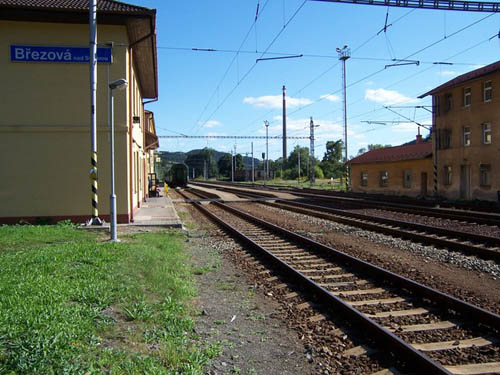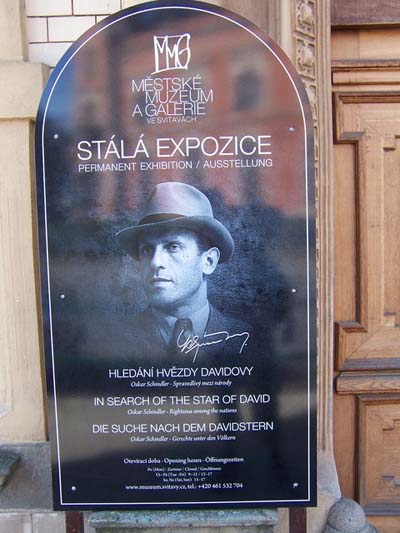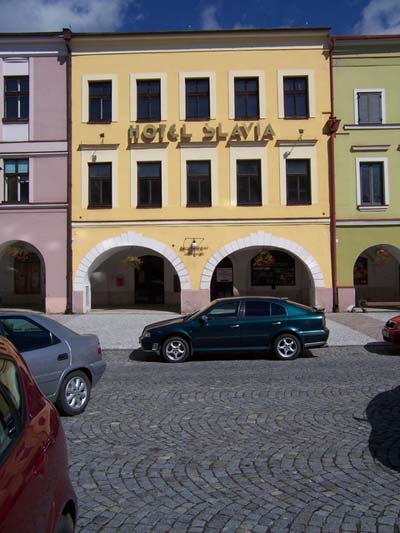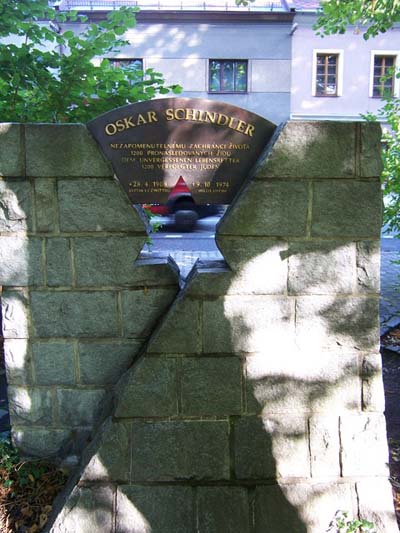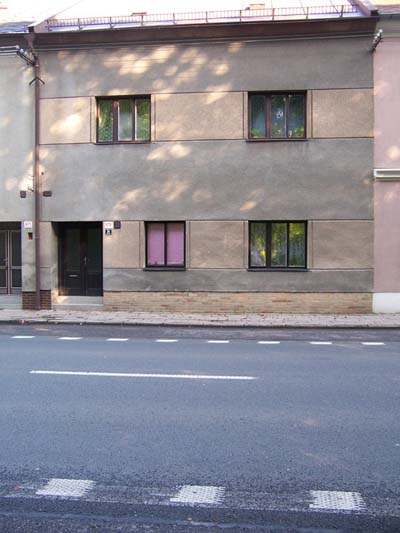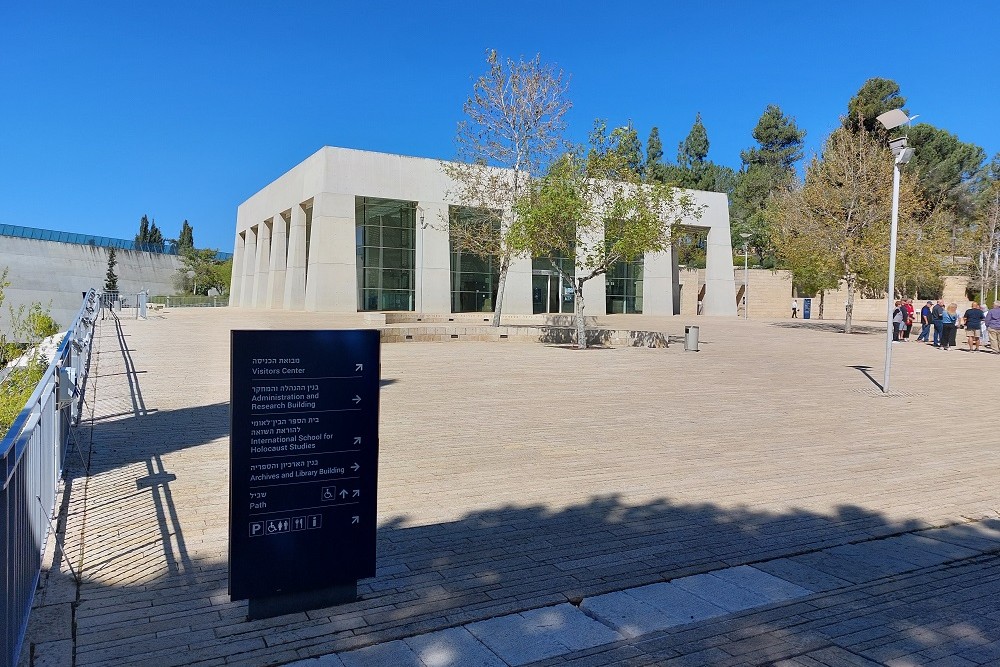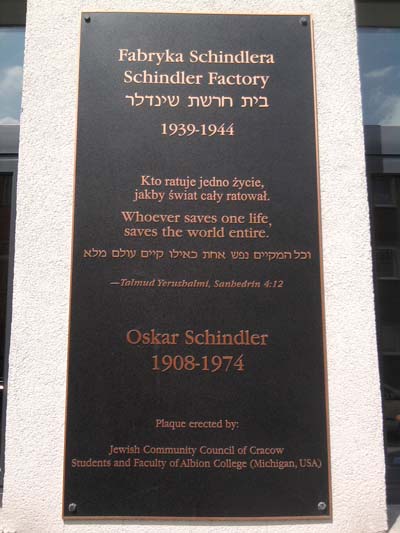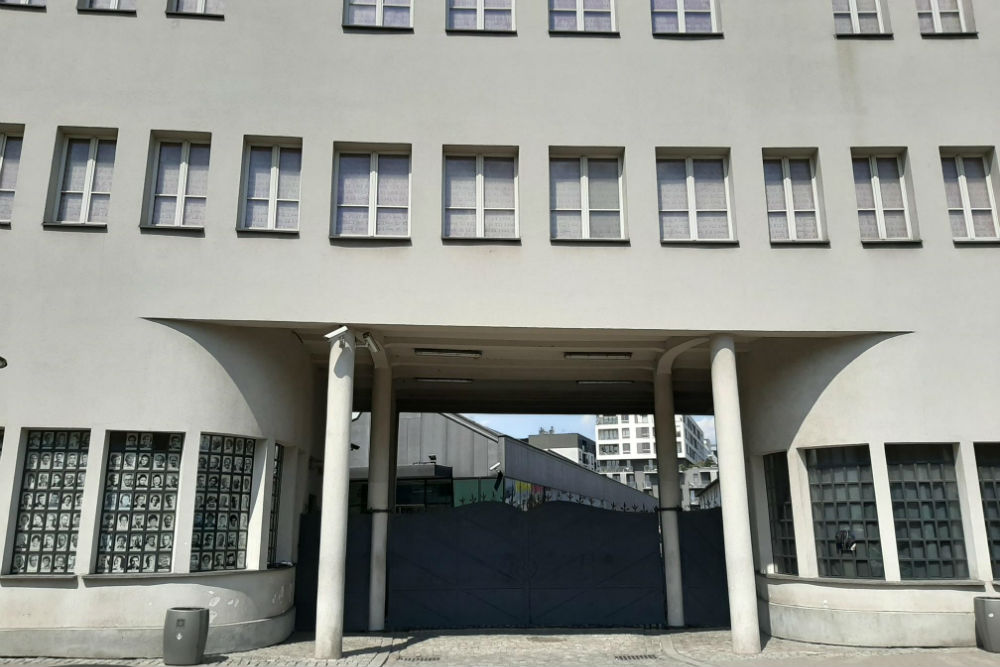Introduction
The person of Oskar Schindler was made famous by Steven Spielberg’s movie Schindler’s List from 1993. The Sudeten-German evolved into a symbol of humanity and courage because he, in his position as a succesful business man during World War Two, had saved the lives of almost 1,100 Jews who were employed by him in his factory. For this, Yad Vashem, the Israelian Holocaust Memorial Center awarded him the title Righteous among the Peoples, an important decoration that is awarded to non-Jews having saved Jews from the Nazis.
It is less well known that Schindler was employed by the Abwehr, the intelligence service of the German Wehrmacht prior to the outbreak of war. He was involved in the preparations for the annexation of the Sudetenland and the invasion of Poland. His recognition as Righteous did not proceed without a hitch as he had been accused of illegally taking over Jewish property at the beginning of the war. Schindler was not free of sins but without his previous history in the Abwehr and his initial opportunistic attitude he would not have been able to save his Jewish employees. Therefore this article paints a complete picture of the life of Oskar Schindler, also pointing out his less than positive actions.
The most important source for this article was the book by David M. Crowe, entitled "Oskar Schindler – de biografie en het ware verhaal achter de Schindler Lijst" (.. the biography and the real story behind the Schindler List), published in 2006 by Verbum Publishers. In this book, Crowe enervates in a convincing way various highly romaniticized elements which have come to dominate the Schindler story without playing down the exceptional heroisme and humanity he surely did display during the war.
Definitielijst
- Abwehr
- Term used for the German military intelligence unit during the WW1 and WW2. From 1935 onwards under command of Admiral Wilhelm Canaris. The organisation often came into conflict with other secret services such as the SD and the Gestapo. During World War 2 under Canaris frequently a source for conspiracies against the Nazi regime until in 1943 a major conspiracy by a number of prominent members of the Abwehr was discovered and the Abwehr was placed under command of Himmler. After the assassination attempt on Hitler in 1944, Canaris was discharged and the Abwehr was dissolved. The conspirators and Canaris were prosecuted and in 1945 they were executed atc oncentration camp Flossenburg.
- Holocaust
- Term for the destruction of European Jewry by the Nazis. Holokauston is the Greek term for a completely burnt sacrifice.
- invasion
- Armed incursion.
- Jews
- Middle Eastern people with own religion that lived in Palestine. They distinguished themselves by their strong monotheism and the strict observance of the Law and tradition. During World War 2 the Jewish people were ruthlessly persecuted and annihilated by the German Nazis. . An estimated 6,000,000 Jews were exterminated.
- Wehrmacht
- German armed military forces, divided in ground forces, air force and navy.
- Yad Vashem
- Yad Vashem is Israel’s national Holocaust memorial where in addition to Jewish victims and resistance heroes, also non-Jewish helpers of Jews during the World War 2 are being honoured. Those non-Jewish are called the Righteous Among The Nations. Until the mid 90’s trees were planted for these rescuers. In 1996 a special remembrance garden was established displaying all of the names of the helpers. Every year new names are added.
Images
Youth, pre war career and marriage
Oskar Schindler was born April 28, 1908 in Svitavy (Zwittau in German), a town belonging to the Austro-Hungarian double empire at the time. After the disintegration of that monarchy at the end of World War One, Svitavy became part of the Czechoslovakian republic. Some 3 million so-called Sudeten-Germans lived in the border region with Germany. Oskar and his family also belonged to them; their language and culture were German first and foremost and not Czechoslovakian. The family belonged to the Catholic middle class. Oskar’s father, Johann Hans Schindler owned a company trading in agricultural machinery. He was married to Franziska Luser and they had two children. Oskar was the eldest and his sister Elfriede was born in 1915. Father Schindler had a weakness for women and alcohol, just like Oskar in his adult life.
Oskar was not a good student. In 1924 he was expelled from the Höheres Realgymnasium for having falsified his report. After his return to school, his classmates called him Schindler the swindler. Thereafter he studied mechanical engineering and heating technique in Brno. After graduation, Oskar worked in the firm of his family. During a business visit to the farm of her father in the spring of 1927, he met Emilie Pelzl whom he married on March 6, 1928. Shortly after he had met Emilie for the first time, he ended the coöperation with his father. He was employed by an electricity company for a short while. After his marriage, he started a driving school. His career was interrupted by a conscription of 18 months in the Czechoslovakian army. Thereafter he returned to the electricity company until it went bankrupt in 1931. He was out of work for a year. He could he not return to his father either as owing to the economic crisis, he had had to close down his business.
The marriage between Emilie and Oskar has never been very good. He spent his free time on motorraces and participated in them as well. In the years before he became jobless, he was away on business trips often. In the year he was jobless, he became addicted to alcohol. Between 1932 and 1938 he was arrested by the police numerous times for public drunkenness, misconduct and maltreatment. He served a few short prison sentences. In order to look for work, Oskar went to Berlin in 1931. He soon returned to Czechoslovakia to start a chicken farm. He quit the farm after six months because he was unable to make money with it. Subsequently he worked for six years as an agent of a bank in Prague. In January 1938 he quit that as well and started selling government property on account payment on orders from a business man. When he was doing better economically, he entered into a relationship with a former school friend who now worked as secretary for his father. He had two extra-marital children with her. Despite his debauchery and volatility, Emilie remained loyal to her husband. Each time she accepted his excuses and she loved his docile nature and helpfulness. Only after the war they would break up definitely.
Images
Activities in the German Abwehr
In 1935, Oskar Schindler joined the Sudetendeutsche Partei of Konrad Henlein. This party advocated linking up with either Austria or Germany. A large majority of Sudeten-Germans voted for Henlein’s party in 1935. They felt supported by Germany where the Nazis, who had been in power since January 1933, strove for redressing the borders to the situation prior to the Treaty of Versailles and incorporating areas with a majority of ethnic Germans within the borders of the German Reich. Preparations were made for the annexation of the Sudetenland from Germany. An important role in this process was reserved for the Abwehr, the intelligence service of the German Wehrmacht. In the Sudetenland, this organization occupied itself with gathering information and counter-espionage but also with the political relations within the Sudeten-German community. It is not known exactly when Schindler started his work for the Abwehr but probably in 1938. In the summer of that year, he collected charts and information on Czechoslovakian troop movements, military strongpoints and other important data of strategic importance to the Kampf- und Sabotage-Verbände (combat and sabotage units) of the Abwehr. Furthermore he recruted Sudeten-Germans with knowledge of vital military information that could be of importance to plans for invasion of the Abwehr.
After he had attempted to recruit a Sudeten-German police officer, Schindler was arrested by the Czechoslovakian secret police on suspicion of spying activities. In a confidential file of the secret police, dated July 28, 1938, it was concluded that Schindler was a very prominent spy and a particularly dangerous person. This was partially based on the reputation of Schindller’s contact in Germany, Peter Kreuzinger. This Abwehr agent was considered one of the leading figures of the spy network of the German Empire. Moreover, Schindler’s name frequently popped up in investigations by the Czech secret police into espionage in Czechoslovakia prior to 1939. It is doubtful whether Schindler was indeed particularly dangerous. In any case, his motivation to work for the Abwehr was questionable. The police commissioner in Brno described him as an extremely frivolous man of doubtful character who was only interested in making money the easy way. Even Schindler himself admitted openly to his interrogators he had joined the Abwehr for financial reasons. Regarding his weakness for women and alcohol, it is likely he needed the money.
It is not exactly known what Schindler was sentenced to. Sources state various punishments: from 2 year in prison to a death sentence. What we do know is that he was imprisoned from July 18 to October 7, 1938 when he was released as a result of the Munich Treaty. This treaty was signed on September 30, 1938 by Germany, Great Britain, France and Italy. Without Czechoslovakia having a say in the matter, this treaty allowed Adolf Hitler (Bio Hitler) to annex the Sudetenland. Chapter 8 of the Treaty stipulated that the Czechoslovakian government was to release Sudeten-German prisoners like Schindler who had been arrested for political crimes. Konrad Henlein became Reichskommissar for the new Sudeten-German territories. Even after the Sudetenland just like Austria, which was annexed in March 1938, had become part of the German Reich, Hitler remained focused on expanding his nation. In March 1939, Czechia was occupied while Slovakia became a German satellite state. Poland would follow in September 1939.
Schindler’s involvement in the annexation of Czechia was only minor because it was not the Abwehr that played the most important role here but the Sicherheitsdienst (Security Service) of the SS. After his release from prison, Schindler was promoted within the Abwehr to deputy commander of a group of agents in Moravian Ostrava on the Czech-Polish border. Meanwhile he had also applied for membership of the N.S.D.A.P. His application was temporarily approved on February 2, 1939 by the district court of the party, pending investigation of two subjects: Schindler’s argument he had continuously been a member of the Sudetendeutsche party since 1935 – required to become a member of the N.S.D.A.P. – and his criminal record of the 30s. A high ranking party official later ruled when Schindler did not suppress any crimes, nothing would stand in the way of his party membership provided: he remains virtuous in nature and politically dependable.
Schindler played a bigger role in the preparations for the invasion of Poland. According to an Abwehr report, he and his 25 agents were actively engaged in smuggling weapons and men to the region of Tĕšín in order to train for secret operations. They are said to have performed similar actions in the region of Žilina. Schindler is also said to have spent much time on the preparation for the German attack on the railway tunnel in the Jablunkov pass in the first hours of the invasion. It is argued he also took part in the preparations for the simulated Polish attack on the German radio station at Gleiwitz (See Statement Naujocks). He is said to have provided the Polish uniforms the concentration camp inmates were dressed in to make them look like the attackers on the transmitting station and who had been killed when the Germans allegedly defended themselves against them. Schindler’s involvement in this is in doubt however because Gleiwitz was outside his area of operations and it had been an operation of the SD, albeit with support by the Abwehr. At the time, Emilie was also involved in Oskar’s espionage activities as chief of his office and his accountant.
Definitielijst
- Abwehr
- Term used for the German military intelligence unit during the WW1 and WW2. From 1935 onwards under command of Admiral Wilhelm Canaris. The organisation often came into conflict with other secret services such as the SD and the Gestapo. During World War 2 under Canaris frequently a source for conspiracies against the Nazi regime until in 1943 a major conspiracy by a number of prominent members of the Abwehr was discovered and the Abwehr was placed under command of Himmler. After the assassination attempt on Hitler in 1944, Canaris was discharged and the Abwehr was dissolved. The conspirators and Canaris were prosecuted and in 1945 they were executed atc oncentration camp Flossenburg.
- concentration camp
- Closed camp where people are being held captive that are considered to be anti- social, enemies of the state, criminal or unwanted individuals. These groups mostly do not get a fair trial or are condemned to doing time in a camp.
- invasion
- Armed incursion.
- Reichskommissar
- Title of amongst others Arthur Seyss-Inquart, the highest representative of the German authority during the occupation of The Netherlands.
- Wehrmacht
- German armed military forces, divided in ground forces, air force and navy.
Images
New opportunities in Krakow
After the German invasion of Poland, Schindler moved to Krakow, one of the first large Polish cities that was captured by the Wehrmacht in September 1939. The city was the capital of the Generalgovernment, the part of Poland that was not annexed but occupied by Germany. The German civil administration was headed by Hans Frank (Bio Frank) who took residence in Krakow. The Generalgovernment played an important role in the history of the Holocaust; it contained a number of ghettos, like the one in Warsaw and four extermination camps. Some 2 million Jews lived in the area. Schindler lived here from 1939 to 1944 and during that time he witnessed all atrocities the Polish Jews were being subjected to. He had come to Krakow for financial reasons. The spy became a business man. The economic climate in the Generalgovernment was favorable because labor was cheap and Jewish enterprises were cheap to take over. Moreover Germany badly needed production capacity for the war industry. Schindler grabbed the chance to make the best use of the circumstances but gradually the opportunist evolved into a savior of human life.
The enterprise Schindler took over in October 1939 was Rekord GmbH, a plant producing enamel ware. In 1939, the three Jewish owners had had to apply for bankruptcy and after the German take over, it had passed to the hands of the German occupier. Schindler could take over the enterprise for a fraction of the actual value. He also took over the entire inventory which had belonged to the Jew Nathan Wurzel. He had been in conflict with the former owners before and would cause great problems for Schindler, in particular after the war when he accused Schindler of having stolen his belongings. Moreover, his business partner Julius Wiener would allegedly have been maltreated by Schindler or, at his instigation, by the Gestapo. Schindler blamed Wurzel – who had worked for him during the war for 18 months – for being involved in "selfish power games at the top of the company." After the war, Schindler has never contradicted the accusations of Wurzel and Wiener outright, nor admitted them. He did recognize however that "it has not been possible to avoid maltreatment under all circumstances". The reproaches damaged his reputation and caused Yad Vashem to formally recognize him as Righteous among the Peoples only after his death.
Schindler’s plant was located in the industrial district of Zablocie, just outside Krakow. He renamed it Deutsche Emailwarenfabrik Oskar Schindler. He named the Jew Abraham Bankier his plant manager. Anyone who has seen Schindler’s List will now raise his or her eyebrows because in the movie this role is played by Itzhak Stern. It is true, Stern did actually work for Schindler but not in the capacity as a plant manager. Stern was an important contact in the office of Amon Göth (Bio Göth), the commander of Plaszow concentration camp where many of Schindler’s employees were interned. He also had ties to the leaders of the Jewish community which was very advantageous for Schindler and in 1944 he started working in Schindler’s new factory in Brünnlitz. Bankier, Schindler’s real plant manager, played an important role. He was an extremely capable manager who was – to a high degree – responsible for Schindler’s financial successes. His contacts on the black market were indispensable. The most lucrative transactions were those with the Wehrmacht. An estimated 80% of Schindler’s business transactions took place on the black market and Bankier accounted for the majority of them. This generated the vast amounts of money Schindler needed to sustain his employees and eventually save them.
In 1940, Schindler owned two other companies, apart from Emalia: a glass factory opposite the main building of the Emalia plant and an enamel ware shop which once belonged to Shlomo Wiener, mentioned above. The glass works produced 1 million vodka bottles a month. Here, between 350 and 380 workers were employed, probably non-Jewish Poles. The company closed its doors in 1943. A few weeks after its opening, 250 Polish laborers worked in the Emalia plant including only seven Jews at that time. In the best year of his enterprise, 1944, he employed, as he stated himself, between 1,700 and 1,750 workers including 1,000 Jews. Initially he had taken in those Jews because they were cheaper still than Polish workers. He also discovered they were more dependable and more productive than Polish workers because their chances of survival in case of absence or an unproductive attitude were minimal. As he watched the Nazis maltreating the Jews more and more, he set himself up as their savior. He saw to relatively good working conditions, gave them extra food and in the end even tried to prevent them from being deported to extermination camps.
Definitielijst
- concentration camp
- Closed camp where people are being held captive that are considered to be anti- social, enemies of the state, criminal or unwanted individuals. These groups mostly do not get a fair trial or are condemned to doing time in a camp.
- Holocaust
- Term for the destruction of European Jewry by the Nazis. Holokauston is the Greek term for a completely burnt sacrifice.
- invasion
- Armed incursion.
- Jews
- Middle Eastern people with own religion that lived in Palestine. They distinguished themselves by their strong monotheism and the strict observance of the Law and tradition. During World War 2 the Jewish people were ruthlessly persecuted and annihilated by the German Nazis. . An estimated 6,000,000 Jews were exterminated.
- Wehrmacht
- German armed military forces, divided in ground forces, air force and navy.
- Yad Vashem
- Yad Vashem is Israel’s national Holocaust memorial where in addition to Jewish victims and resistance heroes, also non-Jewish helpers of Jews during the World War 2 are being honoured. Those non-Jewish are called the Righteous Among The Nations. Until the mid 90’s trees were planted for these rescuers. In 1996 a special remembrance garden was established displaying all of the names of the helpers. Every year new names are added.
Images
Jewish employees
An important scene in the movie is when Oskar Schindler watches from a hill top how Jews in the Krakow ghetto are being brutally herded together by the Nazis in order to be deported. The impression arises that this was The moment Schindler decided to save his Jews. Actually, such a moment is impossible to pinpoint. Schindler’s plant was located close to the ghetto and his employees lived there so he would have been continuously confronted with the deplorable situation from day one. The ghetto was established in March 1941 after 40,000 Jews had already been expelled from Krakow to nearby cities and 11,000 were still left. These remaining Jews were locked up in the ghetto together with Jews from communities in the vicinity of the city. Towards the end of 1941, some 18,000 Jews were living in the overcrowded ghetto, working in factories such as the Schindler plant.
In March 1942, Aktion Reinhard was launched with the ultimate goal of exterminating all Jews in the Generalgovernment. The first massive deportation from the Krakow ghetto took place between May 28 and June 8, 1942. During this Aktion, 300 Jews were killed out of hand and 6,000 were deported to Belzec extermination camp. That had also almost happened to Abraham Bankier, Schindler’s plant manager and 13 other employees. They had been picked up arbitrarily, because being slave laborers, they were exempt from deportation. Schindler was warned about it and when he arrived at the station, they had already been loaded onto the cattle trucks. He managed to get them out. The end of the deportations was still far away though: a second Aktion took place in October 1942. This time, 7,000 Jews were deported to Belzec and Auschwitz while 700 were shot on the spot. It was decided in March 1943 to dismantle the ghetto permanently. The evacuation took place on March 13 and 14 and was directed by SS-Hauptsturmführer Amon Göth, commander of Plaszow camp. 700 Jews were murdered on the spot and 2,300 were deported to Auschwitz. The remaining Jews, including Schindler’s employees, ended up in camp Plaszow.
Camp Plaszow was established in the summer of 1942 as a camp for slave laborers within the city limits of Krakow and it became a concentration camp in January 1944. Amon Göth was its commander from February 1943 to September 1944. Survivors of the camp all agree: Göth was a sadist who derived great satisfaction from maltreating and murdering inmates with his own hands. Schindler’s Jewish employees were now also subjected to the brutal camp regime of this man. Strangely enough, Schindler maintained a friendly relationship with the man who was feared and hated so much by his employees. He was often present at parties in Göth’s villa were both men, along with high ranking SS men and Gestapo officials entertained themselves with alcohol and women. There are big similarities between the brutal camp commander and the humane business man: they both led a frivolous life in which excessive use of alcohol and women played a prominent role. Yet more was hidden behind the seemingly friendliness between the two men.
Owing to his good relationship with Göth, Schindler managed to get permission from the camp commander to set up a satellite camp for his Jewish employees. Schindler’s motivation for this towards the Nazi officials was that his employees would not have to make the daily trip from the camp to the plant and back anymore. Should his employees remain on the premises of the plant, they would have more energy for their work. This would increase productivity and hence be beneficial to German war production. Not only through his powers of persuasion but also by bribes, Schindler managed to persuade Göth and his superiors to set up a satellite camp called Emalia. Construction was probably begun in the spring of 1943. Three large barracks were built with a capacity of some 300 inmates each, two for the men and one for the women. Not only his own employees were housed here but also 450 workers from neighboring plants.
Camp Emalia was a paradise, compared to camp Plaszow. The inmates did not live under constant threat of death and Schindler protected them against the violence that was so normal in Plaszow. Provision of food was also a great difference because Schindler gave them extra food he bought on the black market. Everything points to Schindler doing this from a humane attitude in reaction to all the terror he observed around him. An additional advantage was that his employees fared far better, due to the relatively favorable circumstances in Emalia. Both physically and mentally they were far better off than was habitual in slave labor camps in Nazi Germany. Because of their improved productivity, Schindler was able to make more money as well.
Definitielijst
- concentration camp
- Closed camp where people are being held captive that are considered to be anti- social, enemies of the state, criminal or unwanted individuals. These groups mostly do not get a fair trial or are condemned to doing time in a camp.
- ghetto
- Part of a town separated from the outside world to segregate Jewish population. The establishment of ghettos was intended to exclude the Jews from daily life and from the rest of the people. From these ghettos it was also easier to deport the Jews to the concentration and extermination camps. Also known as “Judenviertel” or Jewish quarter.
- Jews
- Middle Eastern people with own religion that lived in Palestine. They distinguished themselves by their strong monotheism and the strict observance of the Law and tradition. During World War 2 the Jewish people were ruthlessly persecuted and annihilated by the German Nazis. . An estimated 6,000,000 Jews were exterminated.
- Nazi
- Abbreviation of a national socialist.
Images
Important contacts and arrests by the Gestapo
For an important part thanks to his contacts, Oskar Schindler was able to keep his Jewish workers employed, although the extermination of the Jews in the Generalgovernment proceeded relentlessly. His friendly relation with Amon Göth has already been mentioned but he also maintained good contacts with higher officials. Some of those contacts dated back to the period in which he was still working for the Abwehr. An important contact of Schindler was Generalleutnant Maximilian Schindler, head of the Rüstungsinspektion (Inspector of armaments) of the Wehrmacht in the Generalgovernment. The men shared the same family name but were not related although this was to Schindler’s advantage as he let others believe he and the general were related. Maximilian Schindler helped Oskar to important weapons contracts with the Wehrmacht so his plant was considered "indispensable for the war effort" and he could continue to employ his Jewish workers. Up to that time, Schindler produced only pots and pans which were bought by the Wehrmacht but were not really important for the war production. Therefore, in the summer of 1944, Schindler started to produce weapons. It did not amount to much though as the production of arms remained subordinate to the production of enamel ware. In his financial report of 1945, Schindler stated he had produced enamel ware up to an amount of 15,800,000 Reichsmark against military goods valued at no more than 500,000 Reichsmark.
Schindler’s contacts within the Wehrmacht and other important agencies in the Generalgovernment were also important for his own safety. His friendly relation with his Jewish employees and the trouble he took to help them survive made him particularly vulnerable as such exceptional behavior was undesired according to Nazi doctrine. The Gestapo kept a close watch on him and arrested him three times. The first time had nothing to do with his Jewish employees; it happened when he was still working for the Abwehr in Moravian Ostrava. In 1939 a Polish thief had burglarized his home and he had not reported it to the Gestapo as he was supposed to. He was blamed for it as he might have had possible secret information in his possession at the time. The second time he was arrested was at the close of 1941, early 1942 when he was already working in Krakow. He stated himself he was arrested for "fraternization with Jews and Poles." The third time was in the spring of 1942 or 1943. During a birthday party in the plant he had kissed both Jewish and Polish women in front of all present. Somebody had tipped off the Gestapo about it. He was taken to the notorious Gestapo prison in Montelupich. Just like all other times, he was released again soon. Many of his important contacts had been informed and on his release, SS-Oberführer Julian Scherner, SS und Polizeiführer in the Krakow district is said to have declared he had been called by 17 persons vouching for Schindler and urging his release. He was politely brought back home by Gestapo agents.
Something the Gestapo has never discovered was Schindler’s help to Jews which went much further from 1943 onwards that just his activities in Krakow. In that year he began courier work for the Joint Rescue Commission of the Jewish Agency in Palestine. He traveled to Budapest in order to talk to representatives of this Jewish aid organization about the fate of the Jews in the Generalgovernment and the means to help them. He also talked to these representatives in Krakow. Moreover he smuggled money, goods and letters destined for the Jews in camp Plaszow. In that camp, Itzhak Stern was an important contact for Schindler and for the Jewish Agency.
Definitielijst
- Abwehr
- Term used for the German military intelligence unit during the WW1 and WW2. From 1935 onwards under command of Admiral Wilhelm Canaris. The organisation often came into conflict with other secret services such as the SD and the Gestapo. During World War 2 under Canaris frequently a source for conspiracies against the Nazi regime until in 1943 a major conspiracy by a number of prominent members of the Abwehr was discovered and the Abwehr was placed under command of Himmler. After the assassination attempt on Hitler in 1944, Canaris was discharged and the Abwehr was dissolved. The conspirators and Canaris were prosecuted and in 1945 they were executed atc oncentration camp Flossenburg.
- Gestapo
- “Geheime Staatspolizei”. Secret state police, the secret police in the Third Reich.
- Jews
- Middle Eastern people with own religion that lived in Palestine. They distinguished themselves by their strong monotheism and the strict observance of the Law and tradition. During World War 2 the Jewish people were ruthlessly persecuted and annihilated by the German Nazis. . An estimated 6,000,000 Jews were exterminated.
- Nazi
- Abbreviation of a national socialist.
- Wehrmacht
- German armed military forces, divided in ground forces, air force and navy.
Images
Closure of Emalia and The List
During the last two years of the war, the interests of the perpetrators of the Endlösung, represented by the SS collided with those of the war industry, represented by the Wehrmacht. There was an huge shortage of workers and despite the goal of Aktion Reinhard to exterminate all Jews in the Generalgovernment, various factories and workshops continued to employ Jewish slave laborers. In 1943, a few thousand Jews were transferred from camp Plaszow to armament factories in Germany and Poland. In the summer of 1944, Schindler himself still employed some 1,000 Jewish workers. As a result of the advancing Red Army an increasing number of factories in the Generalgovernment were dismantled and industrial activities were transferred to the west. Production in Schindler’s Emalia plant would be continued until early 1945 by 650 Polish workers but in August 1944 he had to start dismantling camp Emalia where his Jewish workers were housed. He obtained permission to keep 300 of his Jewish workers in employment temporarily while the remaining 700 were deported to Plaszow. A large number of them were eventually deported to Mauthausen concentration camp in Austria. When Schindler witnessed a transport involving some of his former employees, he bribed Göth to load drinking water into the cattle trucks and keep the cars wet in order to cool them down during the hot summer day. He also provided the guards on the train with schnapps and cigarettes and asked them to open the sliding doors of the cars whenever the train ride was interrupted.
Schindler was unable to stop the deportation of some of his former employees to Mauthausen but he was determined to continue his rescue work. He wanted to continue part of his production in Sudetenland with his remaining Jews but was thwarted by local authorities who refused to admit Jewish workers. Amon Göth also resisted relocation of his prisoners but that obstacle disappeared on September 13, 1944 when he was arrested by the SS on charges of corruption, maltreatment and murder. Schindler was arrested as well because he was suspected of having bribed Göth but he was released after only eight days. Eventually, by paying bribes and thanks to his contacts with important officials, he managed to obtain permission to set up a factory in Brünnlitz with 300 Jewish women and 700 men. Now begins an important episode in the story of Schindler’s rescue action, the drafting of the list.
Viewers of Schindler’s list will be wondering again because although we see Schindler and Stern drafting the list in the movie, in reality both men did not have much to do with it. The list containing the 1,000 prisoners from Plaszow who were to be transferred to Brünnlitz, was drafted by Marcel Goldberg. He was the corrupt assistant of the new camp commander of Plaszow, SS-Hauptscharführer Franz Joseph Müller. Goldberg’s task consisted of drafting transport lists. The names on the final list were those of prominent Jews from pre war Krakow or important Jewish officials from camp Plaszow. Some Jews had been able to buy their place on the list. Only about one third of the Jews on the list were employees of Schindler. Many Jews who had been working for Schindler for a long time had meanwhile been deported to Mauthausen. Other Jews on the list were for instance the employees of Julius Madritsch. This Viennese business man owned two ready-made clothing plants and a sewing shop in Krakow. Just like Schindler he treated his Jewish workers well. After the war, he and his plant manager Raimund Titsch were awarded the title Righteous among the Peoples by Yad Vashem, just like Oskar and Emilie Schindler.
There is no question of only one list either but there are more. Goldberg’s original lists are dated October 21, 1944 but they differed considerably from the list of the spring of 1945. Then, various names on Goldberg’s original lists had been deleted and replaced by others. Moreover, after the 1,000 Jews from Plaszow had arrived in Brünnlitz, a number of other smaller transports arrived which could be added to the definite list. The list Yad Vashem considers the "original list" is dated April 18, 1945 and contains the names of 801 men and 297 women, almost more than the 1,000 they had started with.
Definitielijst
- concentration camp
- Closed camp where people are being held captive that are considered to be anti- social, enemies of the state, criminal or unwanted individuals. These groups mostly do not get a fair trial or are condemned to doing time in a camp.
- Endlösung
- Euphemistic term for the final solution the Nazis had in store for the “Jewish problem”. Eventually the Endlösung would get the form of annihilating the entire Jewish people in extermination camps.
- Jews
- Middle Eastern people with own religion that lived in Palestine. They distinguished themselves by their strong monotheism and the strict observance of the Law and tradition. During World War 2 the Jewish people were ruthlessly persecuted and annihilated by the German Nazis. . An estimated 6,000,000 Jews were exterminated.
- Mauthausen
- Place in Austria where the Nazi’s established a concentration camp from 1938 to 1945.
- Red Army
- Army of the Soviet Union.
- Wehrmacht
- German armed military forces, divided in ground forces, air force and navy.
- Yad Vashem
- Yad Vashem is Israel’s national Holocaust memorial where in addition to Jewish victims and resistance heroes, also non-Jewish helpers of Jews during the World War 2 are being honoured. Those non-Jewish are called the Righteous Among The Nations. Until the mid 90’s trees were planted for these rescuers. In 1996 a special remembrance garden was established displaying all of the names of the helpers. Every year new names are added.
Images
Arbeitslager Brünnlitz
Oskar Schindler’s new plant was officially named Arbeitslager Brünnlitz, a satellite camp of concentration camp Groß-Rosen. March 15, 1944, 700 male workers for Schindler’s new factory left Plaszow on a transport of 4,000 men to KZ Groß-Rosen for a period of quarantaine. October 21 they were put on a transport to Brünnlitz, arriving the next day. The 300 female workers left October 21 on a transport of in total 2,000 women. They arrived in Brünnlitz by way of extermination camp Auschwitz. This is a dramatic moment in the movie: the women arrived in Auschwitz inadvertently and were in great danger of being gassed. In reality, the intermediate stop the women made between October 22 and November 10 or 12 was probably less dramatic. There were no facilities in Groß-Rosen and no personnel that could receive a transport of women, hence they ended up in Auschwitz. Unlike in the movie, Schindler did not travel to Auschwitz as fast as he could to get his women out. He wasn’t at ease at all when the women had not arrived days after the men. He probably used his military contacts to have his women put on transport by the administration of the concentration camps in Oranienburg.
In addition to the 1,000 Jewish workers, 20 German and 50 Polish employees had come over from Krakow to assist Schindler in running the plant in Brünnlitz. The SS had allocated 100 guards to the Arbeitslager (labor camp), commanded by SS-Obersturmführer Joseph Leipold. Schindler was to provided sustenance for not only the inmates but for the personnel and the guards as well. He also provided the guards with alcohol and tobacco to make them favorably inclined towards himself and to make them leave the Jewish laborers alone. For all that food and luxury goods he again depended on the black market. In the course of time it became so difficult to obtain food Schindler sometimes had to travel 155 miles to get it. Shortly after the war he calculated he had spent a total of 80,000 Reichsmark on food and medicine. Furthermore he was supported by local benefactors; the owner of a grain mill and a wholesale trader in groceries with whom he had attended school. Apart from the shortage of food, there was a shortage of medicine as well. Those were particularly vital when transports of evacuated inmates arrived from other camps.
January 29, 1945, the first transport arrived from labor camp Golleschau, a satellite camp of Auschwitz. Some prisoners had frozen to death during the journey but the survivors were in bad shape as well. There were 81 of them but 10 of them died anyway in the months of February and March, despite the good care of Oskar but above all of his wife Emilie. While she had played only a side role in Krakow, in Brünnlitz she came to the fore more and more and played an important role in saving the Jews. She set up a sick bay where she and several other Jewish doctors, took care of the sick. That winter she even took a dangerous trip to Moravian Ostrava with suitcases full of vodka in order to buy medicine. A second transport arrived five days later, this time from the small Landskron slave labor camp. It contained only six prisoners, two of them died within a month. The deaths of both transport were buried according to Jewish rituals, in violation of all rules in Nazi Germany. Another transport from Geppersdorf with 30 prisoners was still to arrive.
One of Oskar Schindler’s lasting worries was to keep up the pretence his factory was of real importance to the war production. Once again he used his contacts and his powers of persuasion. The plant managers pretended they were working hard on production but actually very little was being produced. Schindler played it down, blaming it on problems starting up his factory. While during the years in Krakow he had sold enamel ware up to an amount of 15 million Reichsmark and half a million of weapons, in Brünnlitz, only one car load of ammunition, valued at 35,000 Reichsmark was produced. To keep his factories in production and his inmates alive, Schindler had to use his profits from Krakow to cover his expenditures. Consequently his assets decreased considerably during the last months of the war. He estimated after the war, it had cost him 2,640,000 Reichsmark to save his Jews. He was left with so little, he would become dependant on financial support from Jewish aid organizations.
Definitielijst
- concentration camp
- Closed camp where people are being held captive that are considered to be anti- social, enemies of the state, criminal or unwanted individuals. These groups mostly do not get a fair trial or are condemned to doing time in a camp.
- Jews
- Middle Eastern people with own religion that lived in Palestine. They distinguished themselves by their strong monotheism and the strict observance of the Law and tradition. During World War 2 the Jewish people were ruthlessly persecuted and annihilated by the German Nazis. . An estimated 6,000,000 Jews were exterminated.
- Nazi
- Abbreviation of a national socialist.
Images
Farewell, escape to Germany and emigration
On January 20 concentration camp Plaszow was liberated by the Red Army. No one was found there anymore as the last inmates had already been evacuated on January 14. As the Soviet armies were advancing further, Schindler had to prevent his camp from being evacuated and liquidated. If that were to happen, chances were great his employees would not survive. He managed to make SS-Obersturmführer Joseph Leipold and his men leave for the front in April and have them replaced by older SS men who behaved themselves more calmly and could be controlled more easily. The safety of their Jewish employees may have been taken care of but then Oskar and Emilie had to think about their own future as well. They did not wish to end up in the hands of the Soviet army and took leave of their employees on May 8. A farewell party was held and Schindler delivered a speech. He urged his Jewish employees to "remain alert and orderly" and that they were to take "righteous and humane decisions." Subsequently he thanked his German personnel for their "unselfish efforts" and the new SS men for their "extraordinary humane and correct attitude." The speech was followed by three minutes of silence for the "countless victims" who had perished during the "horrible years" of the war. Before Oskar, Emilie and some others left on May 9, 1945 at 00:05 in the direction of the American front, the Jews presented him with a gold ring and a written statement saying that from 1942 onwards, he had done everything "to save the lives of as many Jews as possible." According to Thomas Keneally the ring was inscribed with a phrase from the Talmud: "He who saves a single life, saves the entire world."
The Red Army liberated Brünnlitz on May 9,1945. Oskar and Emilie had not managed to stay ahead of the Soviet advance. Disguised as camp inmates however, they managed to avoid being taken prisoner. Eventually they ended up in the American zone of occupation where they were given a travel permit by an American lieutenant of German-Jewish descent. Thanks to the pledges of support from the Schindler-Jews, Oskar did not have to go into hiding and was not subjected to a lengthy deNazification process. In the autumn of 1945, Oskar and Emilie settled down in Regensburg where they were to stay until 1949. In 1947. Oskar found a job importing metal ware and machines at the office of the Jewish Agency of Palestine in Munich. After that office had closed in 1948, he was jobless. The Schindler’s were hoping for a new life abroad and so the plan emerged to emigrate to Argentina. Financial support of the American Jewish Joint Distribution Committee enabled Oskar to set up a company over there.
The vessel carrying the Schindlers berthed in Buenos Aires on November 3, 1949. In the fall of 1950, Oskar set up a small farm in Sao Vicente. Initially they bred table chickens and laying hens but from 1953 onwards, they switched to otters for fur coats. The company was unsuccessful as neither of them knew anything about fur breeding. Oskar soon left the running of the farm to Emilie. Their financial situation deteriorated, just like their marriage. In 1958, Oskar returned to Germany leaving Emilie behind in Argentina. They were never to see each other again.
Definitielijst
- concentration camp
- Closed camp where people are being held captive that are considered to be anti- social, enemies of the state, criminal or unwanted individuals. These groups mostly do not get a fair trial or are condemned to doing time in a camp.
- deNazification
- Post war policy of the allies in Germany to punish Nazi war criminals and to remove known Nazis from positions of power or public service.
- Jews
- Middle Eastern people with own religion that lived in Palestine. They distinguished themselves by their strong monotheism and the strict observance of the Law and tradition. During World War 2 the Jewish people were ruthlessly persecuted and annihilated by the German Nazis. . An estimated 6,000,000 Jews were exterminated.
- Red Army
- Army of the Soviet Union.
Images
Back in Germany, recognition and demise.
Once back in Germany, Oskar Schindler settled in Frankfurt and later in Hildesheim. Businesswise he was not doing well, just like in Argentina. He hoped to take over a successful enterprise but the company he took over in 1962 went bankrupt the next year. His life in the sixties was marked by serious financial and health problems. He drew courage from one thing: his contacts with the Schindler-Jews who honored him as their savior. He visited Israel in 1961 for the first time and would ultimately visit the country 17 times. In those years he was a strong advocate of strengthening the bonds between Germany and Israel. At his first visit, he was welcomed by over 200 of his former employees. From the end of the 40s onwards, the Schindler-Jews had attempted to draw more attention to Schindler’s efforts in order to save them during the war. Various articles on the subject were published in papers and magazines in the United States and Europe.
In 1962 he would be awarded the title Righteous among the Peoples by Yad Vashem but things proceeded differently. A lot of turmoil arose regarding Schindler’s recognition as Righteous as a result of the public charges of theft and maltreatment by Nathan Wurzel and Julius Wiener. On May 1, 1962, Schindler was allowed to plant a Johannes tree on the Avenue of the Righteous at Yad Vashem but after investigation by a special committee the decision was taken to withhold the recognition as Righteous and no recommendation or medal would be presented. To the outside world it made no difference because the tree he had planted stayed there and in practice he was considered Righteous anyway, despite everything else. On June 24, 1993, after his demise, the official recognition followed. Emilie was also recognized as Righteous and her name was added to the tablet near Oskar’s tree on the Avenue of the Righteous.
In the 70s, Oskar’s health deteriorated steadily. He suffered from cardiac problems and serious diabetes. In December 1973 he was struck by a cardiac arrest and became paralyzed on his right side. On September 24, 1974 he was admitted to Saint Bernward Hospital in Hildesheim where he was to get a pace maker. He slipped into a coma during the operation. He did not regain consciousness and passed away on October 9, 1974. He was buried in Jeruzalem in the presence of many Schindler-Jews. Nowadays, his grave is considered the most visited grave in Jeruzalem.
Emilie did not attend her husband’s funeral. She was present however, along with several Schindler-Jews during the shooting of an important scene in the movie that took place at Oskar’s grave. The movie was released in 1993 based on the book "Schindler’s Arc," published in 1982 and written by Thomas Keneally. The movie became a great success and gave much publicity to the story of Oskar Schindler and the history of the Holocaust. Emilie was dissatisfied with the movie, among other reasons because she thought her role in saving the Jews had gotten insufficient attention. Also because her criticism on Oskar, she seemed an embittered woman during interviews at the time. It should not be forgottten though that Oskar had not exactly been the ideal husband and Emilie did play a more important role in saving the Jews than we see in the movie. In her memoirs, published in 1966, she was a lot milder however. She passed away, October 6, 2001, 16 days before her 94th birthday, from a stroke. She was buried in Waldkraiburg cemetery east of Munich.
Definitielijst
- Holocaust
- Term for the destruction of European Jewry by the Nazis. Holokauston is the Greek term for a completely burnt sacrifice.
- Jews
- Middle Eastern people with own religion that lived in Palestine. They distinguished themselves by their strong monotheism and the strict observance of the Law and tradition. During World War 2 the Jewish people were ruthlessly persecuted and annihilated by the German Nazis. . An estimated 6,000,000 Jews were exterminated.
- Yad Vashem
- Yad Vashem is Israel’s national Holocaust memorial where in addition to Jewish victims and resistance heroes, also non-Jewish helpers of Jews during the World War 2 are being honoured. Those non-Jewish are called the Righteous Among The Nations. Until the mid 90’s trees were planted for these rescuers. In 1996 a special remembrance garden was established displaying all of the names of the helpers. Every year new names are added.
Images
Information
- Article by:
- Kevin Prenger
- Translated by:
- Arnold Palthe
- Published on:
- 19-01-2025
- Feedback?
- Send it!
Related sights
Related books
Sources
- CROWE, D.M., Oskar Schindler, Verbum, Laren, 2006.
- KENEALLY, K., Schindlers Lijst, Luitingh Sijthoff B.V., Amsterdam, 2002.
- SPECTOR, S. & ROZETT, R., Encyclopedie van de Holocaust, Kok, Kampen, 2004.
- Deathcamps.org - Oskar Schindler
- Deutsches Historisches Museum - Oskar Schindler
- Jewisch Virtual Library - Oskar Schindler
- Spiegel Online - Oskar Schindler: Vom "Judenküsser" zum "Gerechten der Nationen"
- USHMM - Oskar Schindler
- Yad Vashem - 'De Schindler Lijst' in PDF_formaat
- Yad Vashem - Oskar Schindler
